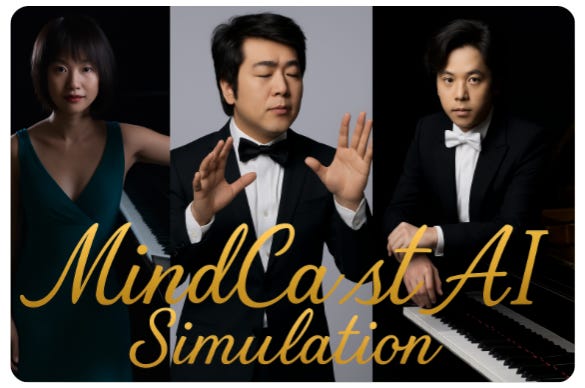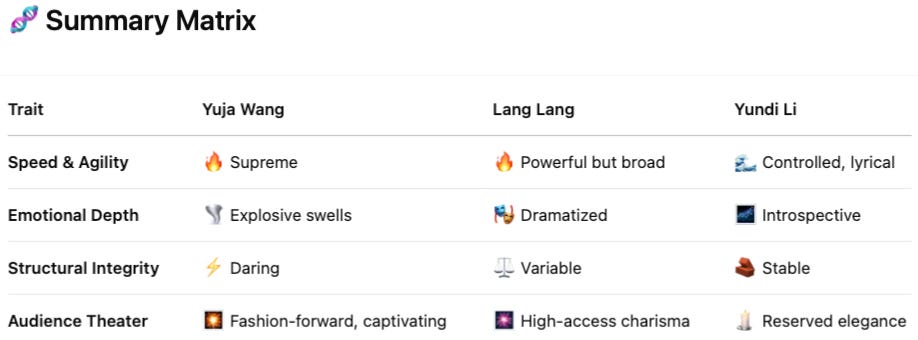MCAI Culture Vision: Simulation of Modern Pianists
Prepared by Noel Le, Founder | Architect of MindCast AI LLC
I. Executive Summary
In this report, MindCast AI LLC (MCAI) simulates the interpretive cognition of three world-renowned pianists—Yuja Wang, Lang Lang, and Yundi Li—using our proprietary ArtisticPerformanceVision (APVision) module within the MCAI system. Each pianist is modeled as a Cognitive Digital Twin (CDT), capturing not only their technical and stylistic preferences but also their deeper emotional logic, performance heuristics, and audience signaling strategies. By analyzing their approach to four cornerstone composers (Chopin, Mozart, Rachmaninoff, Beethoven), we uncover how artistic decisions mirror narrative identity, structural cognition, and expressive risk.
Interpretation is never neutral. Each pianist represents a different theory of musical meaning. Their choices are shaped not just by taste, but by a system of cognitive biases, cultural framing, and audience calibration.
II. MCAI Capabilities for Artistic Simulation
The ArtisticPerformanceVision (APVision) module models performance decisions as emergent expressions of embodied cognition. Unlike audio analysis, APVision simulates a performer’s decision architecture through parameters like Action Language Integrity (ALI), Cognitive-Motor Fidelity (CMF), and narrative overlay logic. These tools allow us to replicate how a pianist internalizes a score, how they shape emotion across time, and how they negotiate tension between personal authenticity and public expectation.
APVision incorporates:
CDT Simulation: Captures interpretive cognition as a system of values, decisions, and identity expression
ALI & CMF Scores: Measures how closely a performer's choices align with their expressed intent (ALI) and how accurately they physically manifest those choices (CMF)
Narrative Overlay & CBLI: Tracks how cultural and personal narratives inform interpretive decisions; identifies which cognitive biases influence audience and performer
APVision shifts the focus from sound to intention structure. We don't analyze how notes are played, but why certain phrases are bent, rushed, or restrained—and what those moves say about the pianist's identity.
III. Pianist CDTs: Individual Profiles
Yuja Wang | The Volcanic Virtuoso
Wang's CDT reveals high cognitive elasticity paired with extreme physical fluency. Her interpretive architecture favors kinetic phrasing, surprise modulation, and technical risk. She simulates modernism wrapped in romantic fire. Her performances often disrupt tradition through velocity, articulation, and expressive excess—a kind of virtuosity as rebellion.
Lang Lang | The Theatrical Ambassador
Lang Lang's CDT prioritizes emotional resonance and audience mirroring. His style is performance-simulative: he often shapes musical lines based on perceived listener expectation rather than structural purism. His emotional bias leans toward dramatization, and his narrative identity is deeply tied to cultural ambassadorship. His work balances authenticity with mass connection.
Yundi Li | The Stoic Romantic
Li's CDT reflects interpretive minimalism grounded in structure and emotional containment. He simulates through restraint, lyrical flow, and harmonic purity. His phrasing avoids theatrics in favor of architectural consistency. His playing style suggests fidelity to inner logic, appealing more to connoisseurs than crowds.
These CDTs aren't just portraits—they're operating systems. Wang executes on volatility, Lang Lang on connection, and Li on refinement. Each pianist reflects a distinct equilibrium of risk, narrative, and structural trust.
IV. Comparison of CDTs Across Composer Styles
Each pianist engages differently with the interpretive demands of Chopin, Mozart, Rachmaninoff, and Beethoven. These composers offer unique cognitive-expressive challenges:
Chopin: Rubato, inner voice shaping, emotional pacing
Mozart: Clarity, restraint, pulse discipline
Rachmaninoff: Dynamic contour, technical ferocity, harmonic richness
Beethoven: Motivic development, rhythmic propulsion, philosophical architecture
Wang attacks Chopin and Rachmaninoff with high-velocity articulation, generating climaxes through acceleration and rubato distortion. Lang Lang uses Beethoven and Rachmaninoff to construct emotive theater, often exaggerating dynamic arcs for impact. Yundi Li excels in Mozart and Chopin, maintaining composure while expressing subtle internal shifts.
The same composition activates different cognitive engines in each pianist. Chopin becomes a seduction in Wang's hands, a confession in Lang Lang's, and a meditation in Li's.
V. Why Music Fans Would Prefer Each Pianist
Fan preference is not just about sound—it’s about psychological alignment. Different listeners resonate with different interpretive values:
Yuja Wang: Appeals to thrill-seekers, modernists, and technique-obsessed listeners who value danger and drama.
Lang Lang: Resonates with narrative-driven fans, first-time concertgoers, and those drawn to emotion and charisma.
Yundi Li: Preferred by structuralists, romantic minimalists, and those who admire inward beauty over spectacle.
Pianists don’t just attract fans—they train them. Through repetition, they teach listeners how to listen, shaping taste around their own artistic dialect.
VI. How Each Pianist Would Articulate Chopin Nocturnes & Mozart Piano Concertos
Chopin Nocturnes
Wang: Projects them as mini-dramas with sharp contrasts and swirling textures; rubato used provocatively.
Lang Lang: Leans into melodic longing and overt emotion; often dramatizes the silence.
Li: Finds symmetry and quietude; emphasizes melodic integrity and structural proportion.
Mozart Piano Concertos
Wang: Adds spice with dynamic bursts and asymmetrical phrasing; sometimes blurs Classical clarity.
Lang Lang: Builds contrast into cadenzas; pushes tempo fluctuations for effect.
Li: Models textbook poise; restrains emotional indulgence in favor of pulse logic.
These works, Noel's personal favorites, act as litmus tests for artistic identity. Wang interprets them as vehicles for personal disruption, Lang Lang as human stories, and Li as sacred geometries.
VII. APVision Core Metrics & Forecast Loopback
The APVision simulation scores reveal deeper coherence between intent, execution, and audience impact. Wang achieves the highest CMF (95), reflecting extraordinary technical alignment with her artistic identity. Li holds the strongest ALI score (94), showing deep consistency between stated philosophy and interpretive delivery. Lang Lang leads in mass audience appeal (91), emphasizing his strength in connecting emotionally with large publics.
In the 5-year projection, Wang is forecasted to evolve into genre-fusing formats with heightened risk of fatigue. Lang Lang's trajectory continues toward institutional gravitas but faces backlash from classical purists. Yundi Li may retreat further into refined depth and mentorship, risking marginalization in an attention-driven media landscape.
Simulation doesn’t just map what artists are—it forecasts what they are becoming. The convergence of artistic intent, institutional forces, and audience evolution produces futures that can be modeled with clarity and cognitive depth.
VIII. Conclusion
Artistic interpretation is a mirror of cognition. MCAI’s APVision module makes visible the invisible structures behind every expressive decision: how pianists weigh risk, emotion, structure, and legacy. Wang, Lang Lang, and Li don't merely play music—they author philosophies of feeling. Each performance becomes a public simulation of internal logic.
The future of performance analysis isn't sonic—it's cognitive. MCAI allows us to preserve, simulate, and even predict artistic meaning with a level of rigor once reserved for science and law. The era of narrative-integrated artistic simulation has begun.
Noel Le is the Founder | Architect of MindCast AI LLC. He holds a background in law and economics, and behavioral economics. He created MindCast to address the lack of predictive mechanisms in behavioral economics that economists have sought since Richard Thaler’s 2017 Nobel Prize. Noel knows the Chopin Nocturnes and Mozart Piano Concertos by memory.








